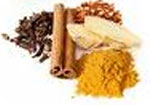| Tuesday, 13 May 2025 Home • About Us • Contact Us |
|
|
|
You are here:
Spices not only add flavor to food and help to liven it up, but research is now showing that spices have many health benefits. A new study has found that the active ingredients in several common spices prevent platelet aggregation and blood clot formation up to 29 times better than aspirin, and without the side effects.
Study Details Scientists in India carried out extensive testing to determine the health benefits of spices traditionally used in Indian cuisine. They evaluated the effect of the principle spice active compounds eugenol, capsaicin, piperine, quercetin, curcumin, cinnamaldehyde, and allyl sulphide on human platelet aggregation. They demonstrated that each compound evaluated was able to significantly inhibit blood clotting. Eugenol and capsaicin, the active ingredients in commonly used spices, were found to be the most potent inhibitors of platelet aggregation, with eugenol found to be 29-times more potent than aspirin in inhibiting arachidonic acid induced human platelet aggregation. Arachidonic acid is an omega-6 unsaturated fat, found in high quantities in animal fats, such as red meat. Research paper details: Raghavendra RH, Naidu KA. Spice active principles as the inhibitors of human platelet aggregation and thromboxane biosynthesis. Prostaglandins, Leukotrienes and essential fatty acids Article in Press June 2009. Previous research from this team of scientists found that eugenol was also highly effective at inhibiting enzymes implicated in inflammatory conditions including disorders like asthma, allergic rhinitis, arthritis, inflammatory bowel disease and psoriasis. Research paper details: Raghavenra H, Diwakr BT, et al. Eugenol-The active principle from cloves inhibits 5-lipoxygenase activity and leukotriene-C4 in human PMNL cells. Prostaglandins, Leukotrienes and essential fatty acids, Volume 74, Issue 1, January 2006, Pages 23-27 Eugenol Eugenol is found in cinnamon, lemon balm, bay leaves and gives cloves their distinct aroma. It is also available as an essential oil, and because it is extracted from cloves, it is sometimes refered to as clove oil. Medicinally, eugenol can be used as an analgesic, and has antiseptic and antibacterial effects. A good way to obtain this active compound through the diet is by spicing up food by adding whole or ground cloves to dishes. Capsaicin Capsaicin is the active compound found in chili peppers, and is responsible for the intensity of the heat of the pepper. Much research has been carried out on this compound, and aside from reducing blood clotting, capsaicin has been found to fight cancer, provide pain relief, reduce inflammation, control diabetes and weight loss. Chili peppers are a main ingredient in hot sauce, which can be sprinkled on a whole variety of dishes. Alternatively, add fresh chili peppers to food when preparing them. Curcumin is one of the best known and researched natural healing spices. It is the active ingredient in turmeric, a spice that is regularly used in Asian cooking. Research has shown curcumin to have strong antioxidant, anti-inflammation, antifungal and antiviral properties. It is also known to be a very effective pain reliever, aids digestion, fights infections and reduces heart attacks, as well as numerous other health benefits. Turmeric, with its deep yellow-orange color, is an ingredient in curry powders but is also available as turmeric powder on its own, and this form contains the most curcumin. Cinnamaldehyde Cinnamaldehyde is the chemical compound that gives cinnamon its flavor and aroma. Cinnamon is well known to be an effective and popular healer. It has been found to regulate blood sugar levels and have sedative and antibiotic properties, as well as regulate digestion and tackle bad breath. To include cinnamon in the diet, chew daily on a fresh cinnamon stick, or add fresh or ground cinnamon to food and drink. Piperine Piperine is the active ingredient in black pepper and is what gives black pepper its kick. This compound provides an overall health boost, acts as a powerful antioxidant, reduces inflammation and pain, combating arthritis and fighting off colon cancer. Black pepper has also been shown to substantially increase the bioavailability of nutrients from food, and has a dual action in speeding toxins out of the body through sweat and urine. Allyl Sulfide Allyl sulfide is found in the oil of garlic and is one of the compounds that gives garlic its unique odor. Garlic is a potent herb with well known anti-inflammatory and anti microbial properties, and research suggests that garlic is a powerful antioxidant that can help lower high blood pressure and control diabetes, as well as protect against cancer. Garlic is very versatile and can be added to almost any savory dish. Crushing garlic before using releases more of its beneficial compounds, and lightly cooking it also preserves much of its nutritional value. Tips for Using Spices
Link to this article: Show: HTML Link • Full Link • Short Link
Related Articles:
You must be registered and logged in to comment. |
|
 |
 | |
|
|








